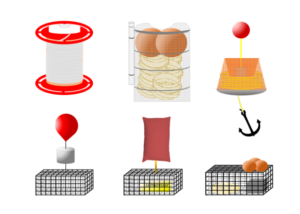On-Demand Fishing
WHAT IS ON-DEMAND FISHING?
On-demand fishing (also known as ropeless, buoyless, remote-release or pop-up) pots and creels use triggers to release buoys, attached to submerged pots/creels, allowing them to float to the surface for retrieval. Such systems may be time controlled or use acoustic triggers, and negate the need for vertical lines in the water column, which pose a threat of entanglement for marine mammals and turtles.

Ropeless gears. (Top: Fiobuoy, DesertStar ARC-1, Ashored-Mobi. Bottom: LobsterLift, SMELTS LobsterRaft, EdgeTech 5112). Image credit: Kim Sawicki
CURRENT RESEARCH
Timed systems, which release pots at a pre-specified time, are potentially less effective than acoustic-release triggers, as they risk releasing when fishers are not yet in the vicinity. However, the technology is being refined to be more effective and cheaper. Successful testing has been completed in the USA for traps for lobster, crab, and bass to depths of about 90 metres in various ocean conditions and bottom types. A successful feasibility study was conducted in 1999 for the use of acoustic release systems in offshore lobster fisheries in the Gulf of Maine, USA, demonstrating that such systems could successfully be deployed. As yet, their implications for mitigating bycatch is undetermined, although trials are underway in Scotland and North America, and acoustic-release triggers are already in use in southern rock lobster fisheries in New South Wales, Australia. Researchers are also exploring the promising potential of technology that enables ropeless/buoyless pots to accurately report their locations to fishing and other vessels, although this is still in early stages.
Switching to on-demand systems is not always feasible nor desirable. The Scottish Entanglement Alliance (SEA) recommends other ways to mitigate entanglement risk by reducing excess rope or loops of rope in the water column. One is to set the riser (endline) length to the water depth and use a weighted rope on the riser. Another is to use negatively buoyant rope in groundline, to ensure that groundline lies on the seabed rather than floating in loops between pots. Recent research by the SEA has shown that a high proportion of whale and basking shark entanglements are caused by these groundline loops, and a trial with Scottish creel fishermen on the west coast in 2022–2024 suggested sinking groundline might be feasible to implement. Go to our page on sinking groundline for more information.
Interested in how this and other measures could mitigate bycatch in your fishery? Get in touch with us to collaborate or take part in a study.
This page was last updated on 10.12.24.
